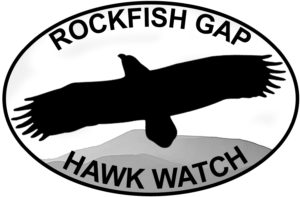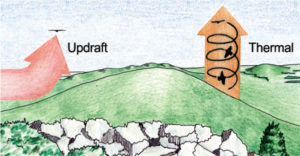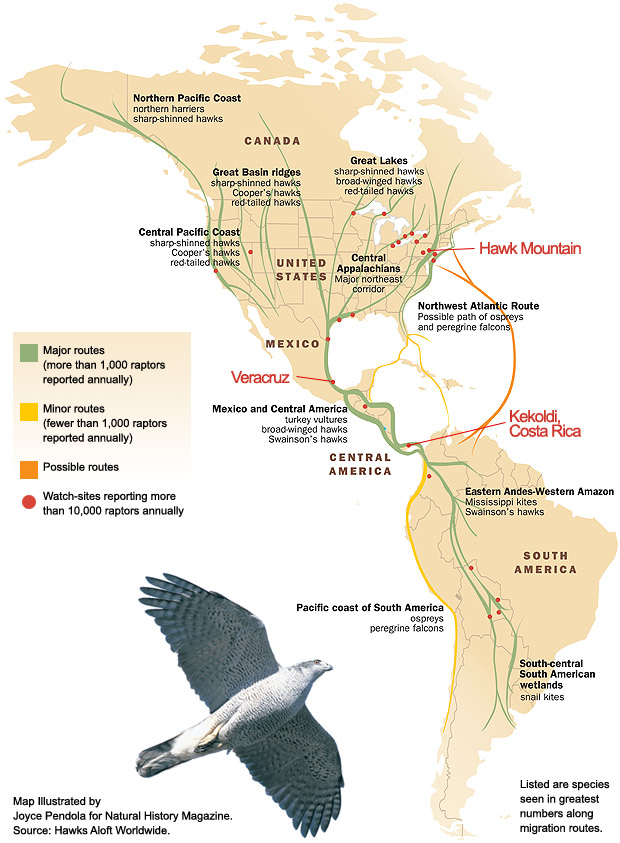What is a hawk watch?
A hawk watch is a systematic and organized effort to collect standardized migration count data about diurnal raptors. Records include species identities (including color morph, sex and age classes when possible), numbers quantities, and behaviors of seasonal migrant hawks; data on weather and observation conditions; and a measure of sampling effort that includes number of observers and hours of observation. Observations at a hawkwatch are conducted on a regularly repeated basis (daily or nearly daily) from a single monitoring site.
Why watch and count hawks?
1) It’s scientifically useful. Scientists study raptor migration to monitor changes in raptor populations. All hawk watch sites submit their records to HMANA, which then makes the data available to researchers around the world.
2) It’s ecologically important. Raptors are sensitive bio-indicators at the top of food chains, and changes in raptor numbers reflect changes in environmental health.
3) It’s challenging. Distinguishing the identity of species in flight, often at great distances, can be quite difficult. This tests one’s identification skills to the limit.
4) It’s thrilling. Raptors are graceful, dynamic, wild and free. They migrate in great numbers and often relieve the tedium of migration by engaging in stunning aerial spectacles and combat.
How and why do birds migrate?
Many raptors migrate seasonally to more favorable climates. In general, these movements are linked to the availability of food. Some birds survive year-round in one location, often by utilizing a variety of food resources at different times of year.
 In some species of raptors, every individual migrates. In other species, only part of the population migrates and some individuals remain on the breeding grounds. Other species are completely sedentary. Overall, about 45 percent of all raptor populations migrate. Although most small birds migrate at night to avoid predators such as raptors, hawks migrate during the day, generally over land, utilizing updrafts or rising columns of air called thermals. Raptors gain lift inside a thermal without flapping and then glide to another thermal. This enables them to migrate in an energy-efficient manner, primarily by gliding and not by actively flapping their wings. Most raptors migrate over land. Large bodies of water do not produce strong thermals and are generally avoided. This effectively funnels most migrant raptors through Central America, a narrow land bridge. Because of this phenomenon, flocks of several thousand raptors of many different species can be seen during migration in many Central American countries.
In some species of raptors, every individual migrates. In other species, only part of the population migrates and some individuals remain on the breeding grounds. Other species are completely sedentary. Overall, about 45 percent of all raptor populations migrate. Although most small birds migrate at night to avoid predators such as raptors, hawks migrate during the day, generally over land, utilizing updrafts or rising columns of air called thermals. Raptors gain lift inside a thermal without flapping and then glide to another thermal. This enables them to migrate in an energy-efficient manner, primarily by gliding and not by actively flapping their wings. Most raptors migrate over land. Large bodies of water do not produce strong thermals and are generally avoided. This effectively funnels most migrant raptors through Central America, a narrow land bridge. Because of this phenomenon, flocks of several thousand raptors of many different species can be seen during migration in many Central American countries.
Do raptors follow certain paths for migration?
[From Hawk Mountain webpage]

Raptors usually migrate across a broad front over level terrain. High mountain ranges, oceans, and lakes are obstacles for migrants, creating leading lines and concentrating birds along narrow pathways. In North America, where the major mountain chains run north-south, cross winds hit the ridges and create updrafts favorable for slope soaring. Hawk Mountain is on the Appalachian Flyway. For South American destinations, the major route for soaring species is through Mexico and Central America. More than a million turkey vultures, and broad-winged hawks have been counted at Veracruz, Mexico, where two barriers—the Sierra Madre mountains on the west, and the Atlantic Ocean on the east funnel migrants through a narrow corridor. Scarcity of food is the primary reason that most North American hawks leave their breeding territories in winter. Why raptors return in the spring is not so obvious. Ecologists believe lower predator and parasite populations, longer days for hunting, and most of all, more abundant food supplies increase breeding success in the temperate zone.
What happens to the hawk watch data?
Once the data is submitted to the HawkCount.org database, it becomes part of the largest repository of raptor migration counts collected over in North America. As stated above, you can choose to restrict access to your data or share it freely or on a limited basis with others. You retain at all times ownership of the data. Most sites, however, choose to distribute the data freely. HawkCount.org is connected to even larger observational record repositories such as Cornell University’s Avian Knowledge Network and the Global Biodiversity Information Facility and researchers and decision makers from all over the world can have access to it for a variety of uses, primarily research and education. The primary use of the migration count data is calculation of population trends of hawks, through the Raptor Population Index Project which makes periodic analyses of status of raptors across the continent.
How important is identification expertise?
Observers must identify migrant raptors accurately at the species level. A conservative target goal is to positively identify 90% of the migrants. Some hawkwatches also age and sex birds and keep track of color morphs, although these variables are not currently being used in the RPI analysis, they provide a great deal of additional information. The monitoring site should always be staffed by at least one qualified observer possessing extensive experience and skill identifying hawks in flight. Most sites have two observers on duty at all times, and the number of official observers covering the monitoring site is an important element of consistency in operating a hawkwatch.
How does one learn to be a hawk watcher?
Learning to identify raptors can be challenging. Watching in the company of more experienced people will help. Don’t be afraid to ask questions as we are here to help and share our knowledge. A good pair of binoculars and a field guide are essential. Some excellent guides for hawk identification can be found here. As for binoculars, 8 x 42 or 10 x 42 are excellent choices. Purchase the best that you can afford because cheap binoculars will not satisfy or hold up.
When is the hawk watch held and what can be seen?
Weather permitting, the hawk watch is conducted every day from August 15 through November 30. Hawks usually do not migrate during rain or heavy fog. There are 16 species of raptors that migrate through Rockfish Gap Hawk Watch (see below). The greatest number of hawks are seen during the last two weeks of September. The 10-year average for total number of migrating raptors counted each fall is 27,931.
Our annual species records are:
33,017 Broad-winged Hawk
3,654 Sharp-shinned Hawk
2,100 Red-tailed Hawk
480 Bald Eagle
455 Cooper’s Hawk
403 American Kestrel
373 Osprey
168 Red-shouldered Hawk
159 Northern Harrier
85 Merlin
65 Peregrine Falcon
40 Golden Eagle
18 American Goshawk
10 Mississippi Kite
3 Rough-legged Hawk
2 Swainson’s Hawk
